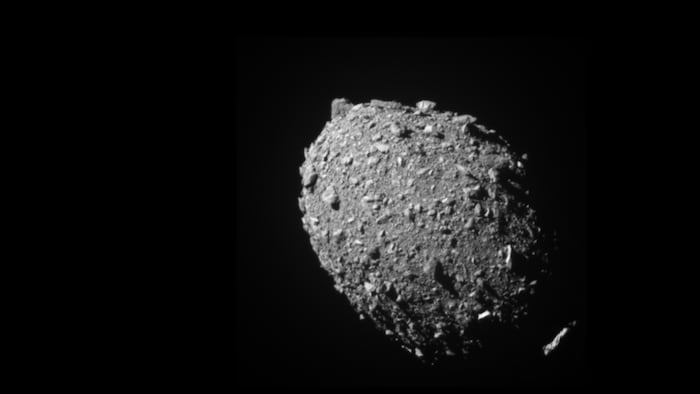Open in full screen mode The asteroid Dimorphos, seen by the DART probe, 11 seconds before impact. It was 68 kilometers from the impact site. This image is the last to contain the entirety of Dimorphos in the field of view. Agence France-Presse The asteroid Dimorphos, the subject of a unique experiment to deviate its trajectory, looks like a pile of debris from the larger asteroid Didymos around which it is in orbit, a study shows published in the journal Nature Astronomy (New window) (in English). Dimorphos was struck in September 2022 by the NASA's DART spacecraft to experiment with the ability to deflect an asteroid that might hit Earth from its trajectory.
The asteroid Didymos (top left) and its satellite, Dimorphos, approximately 2.5 minutes before DART's impact with the latter. The image was taken by the DRACO imager at a distance of 920 kilometers.
The success of the mission, which occurred some 11 million kilometers from Earth, could only be measured by the consequence of the impact in the orbit of Dimorphos around Didymos.
In this strange couple, the first star, measuring approximately 160 meters in diameter, initially circled the second and its 800 meters in diameter, in almost 12 hours. A time shortened by more than half an hour after impact. The detail was captured in images by an Italian microsatellite which accompanied the DART mission, and followed by the Earth by telescopes.
According to the international team led by Sabina Raducan, specialist in small celestial bodies at the University of Bern, these data suggest that Dimorphos is a pile of debris, summarizes her study.
Loading
One of the most wanted criminals in Quebec suspected of the kidnapping of a Saguenéan
ELSE ON INFO: One of the most wanted criminals in Quebec suspected of the kidnapping of a Saguenéan
According to the simulations, the only solutions that we find suppose that initially Dimorphos was a very fragile star which offered very little resistance to the impact of DART and its 610 kg, explains study co-author Patrick Michel, astrophysicist at the Côte d'Azur Observatory.
Such fragility that the impact, instead of only making a crater of around ten meters in diameter, would in fact have resulted in an entire deformation of the body of the star, adds this co-responsible for the DART team.
The use of the conditional is essential while waiting for the HERA probe of the European Space Agency (ESA), which must reach Dimorphos in 2026, to come and examine the asteroid with much more substantial means .
Dimorphos would be made up of a heterogeneous assemblage based on silica, but not the type of sand field like in Saint-Tropez, rather a field of pebbles like on the Promenade des Anglais in Nice, with rocks everywhere, smiles Patrick Michel . Rather small rocks, since less than 40% are more than 2.5 meters, according to simulations supported by the last images taken by DART before the ship crashed.
And above all the structure of the star, which a low-frequency radar from HERA will make it possible to auscultate, would be characterized by great porosity, explaining its fragility.
Which argues in favor of birth, and growth, based on debris ejected by its big brother Didymos, which spins on it -even like a top, of which it has a bit of a shape. With sufficient speed to eject part of its material by centrifugal effect, which agglomerates to form Dimorphos.
This in itself would be good news for Patrick Michel, confirming that a silicate asteroid like Dimorphos has roughly the same behavior as the most common carbonaceous ones, like Bennu or Ryugu, i.e. say very little resistance.
We would therefore already know who we are dealing with, if necessary in the distant future in deflect one to save the Earth. A major breakthrough because these objects have behavior that defies our intuition, due to their environment being very different from that of Earth, underlines the expert.
In 2029, the asteroid Apophis will pass close to Earth, some 32,000 kilometers away, providing a natural laboratory for the study of these stars, he anticipates.
A mission is being prepared to study the behavior of Apophis during its passage, without the need to touch it since it will be, him, visible from the ground.

